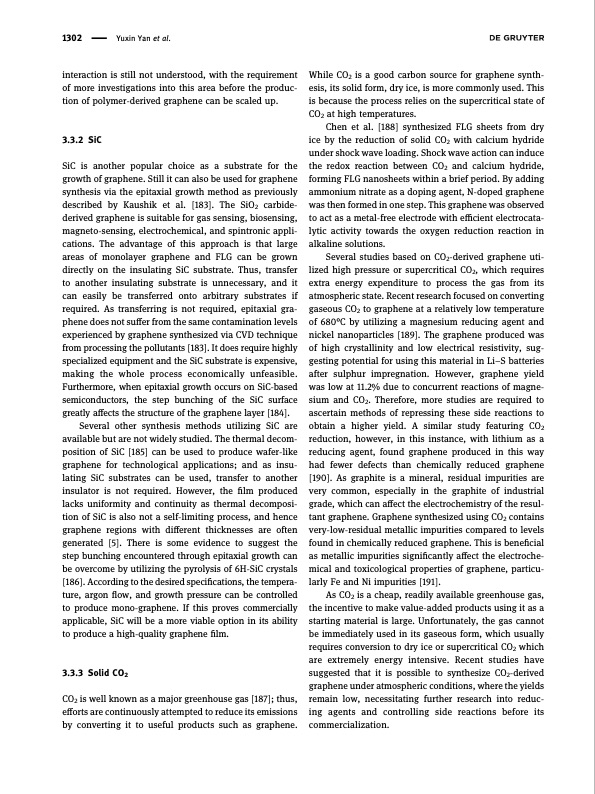PDF Publication Title:
Text from PDF Page: 019
1302 Yuxin Yan et al. interaction is still not understood, with the requirement of more investigations into this area before the produc- tion of polymer-derived graphene can be scaled up. 3.3.2 SiC SiC is another popular choice as a substrate for the growth of graphene. Still it can also be used for graphene synthesis via the epitaxial growth method as previously described by Kaushik et al. [183]. The SiO2 carbide- derived graphene is suitable for gas sensing, biosensing, magneto-sensing, electrochemical, and spintronic appli- cations. The advantage of this approach is that large areas of monolayer graphene and FLG can be grown directly on the insulating SiC substrate. Thus, transfer to another insulating substrate is unnecessary, and it can easily be transferred onto arbitrary substrates if required. As transferring is not required, epitaxial gra- phene does not suffer from the same contamination levels experienced by graphene synthesized via CVD technique from processing the pollutants [183]. It does require highly specialized equipment and the SiC substrate is expensive, making the whole process economically unfeasible. Furthermore, when epitaxial growth occurs on SiC-based semiconductors, the step bunching of the SiC surface greatly affects the structure of the graphene layer [184]. Several other synthesis methods utilizing SiC are available but are not widely studied. The thermal decom- position of SiC [185] can be used to produce wafer-like graphene for technological applications; and as insu- lating SiC substrates can be used, transfer to another insulator is not required. However, the film produced lacks uniformity and continuity as thermal decomposi- tion of SiC is also not a self-limiting process, and hence graphene regions with different thicknesses are often generated [5]. There is some evidence to suggest the step bunching encountered through epitaxial growth can be overcome by utilizing the pyrolysis of 6H-SiC crystals [186]. According to the desired specifications, the tempera- ture, argon flow, and growth pressure can be controlled to produce mono-graphene. If this proves commercially applicable, SiC will be a more viable option in its ability to produce a high-quality graphene film. 3.3.3 Solid CO2 CO2 is well known as a major greenhouse gas [187]; thus, efforts are continuously attempted to reduce its emissions by converting it to useful products such as graphene. While CO2 is a good carbon source for graphene synth- esis, its solid form, dry ice, is more commonly used. This is because the process relies on the supercritical state of CO2 at high temperatures. Chen et al. [188] synthesized FLG sheets from dry ice by the reduction of solid CO2 with calcium hydride under shock wave loading. Shock wave action can induce the redox reaction between CO2 and calcium hydride, forming FLG nanosheets within a brief period. By adding ammonium nitrate as a doping agent, N-doped graphene was then formed in one step. This graphene was observed to act as a metal-free electrode with efficient electrocata- lytic activity towards the oxygen reduction reaction in alkaline solutions. Several studies based on CO2-derived graphene uti- lized high pressure or supercritical CO2, which requires extra energy expenditure to process the gas from its atmospheric state. Recent research focused on converting gaseous CO2 to graphene at a relatively low temperature of 680°C by utilizing a magnesium reducing agent and nickel nanoparticles [189]. The graphene produced was of high crystallinity and low electrical resistivity, sug- gesting potential for using this material in Li–S batteries after sulphur impregnation. However, graphene yield was low at 11.2% due to concurrent reactions of magne- sium and CO2. Therefore, more studies are required to ascertain methods of repressing these side reactions to obtain a higher yield. A similar study featuring CO2 reduction, however, in this instance, with lithium as a reducing agent, found graphene produced in this way had fewer defects than chemically reduced graphene [190]. As graphite is a mineral, residual impurities are very common, especially in the graphite of industrial grade, which can affect the electrochemistry of the resul- tant graphene. Graphene synthesized using CO2 contains very-low-residual metallic impurities compared to levels found in chemically reduced graphene. This is beneficial as metallic impurities significantly affect the electroche- mical and toxicological properties of graphene, particu- larly Fe and Ni impurities [191]. As CO2 is a cheap, readily available greenhouse gas, the incentive to make value-added products using it as a starting material is large. Unfortunately, the gas cannot be immediately used in its gaseous form, which usually requires conversion to dry ice or supercritical CO2 which are extremely energy intensive. Recent studies have suggested that it is possible to synthesize CO2-derived graphene under atmospheric conditions, where the yields remain low, necessitating further research into reduc- ing agents and controlling side reactions before its commercialization.PDF Image | Synthesis of graphene Potential carbon precursors

PDF Search Title:
Synthesis of graphene Potential carbon precursorsOriginal File Name Searched:
10-1515-ntrev-2020-0100.pdfDIY PDF Search: Google It | Yahoo | Bing
Salgenx Redox Flow Battery Technology: Power up your energy storage game with Salgenx Salt Water Battery. With its advanced technology, the flow battery provides reliable, scalable, and sustainable energy storage for utility-scale projects. Upgrade to a Salgenx flow battery today and take control of your energy future.
CONTACT TEL: 608-238-6001 Email: greg@infinityturbine.com (Standard Web Page)